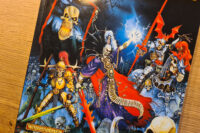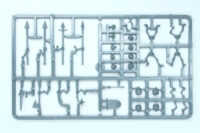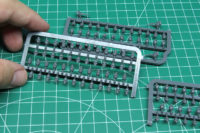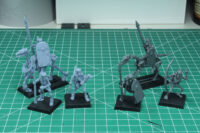Warhammer The Old World – Who are the Tomb Kings of Khemri?
We talked about, where the Bretonnians came from, and now it is time to talk about where the Tomb Kings of Khemri came from. In the early editions of Warhammer Fantasy, the undead were just generic evil, aligned with Chaos and Orcs.
You had the basic tropes, with Skeletons, Mummies, Ghouls and such. Just like you would find them in any roleplaying game bestiary. And in Warhammer Armies the undead became a play-able faction, build around a Necromantic force, that would command an army of the undead to raise and further creatures to rally around it.
In 1986 one of the first plastic kits ever to be produced by Citadel Miniatures, there was the Citadel Skeleton Horde (PBS1) and provided Skeleton Warriors. The later released Skeleton Army (PBS5) would add horsemen and chariots to it, in plastic as well. These models would be used long until the 4th and 5th edition of Warhammer Fantasy.
In 1994 the first army book for the Undead was released for Warhammer, during the 4th edition of Warhammer Fantasy. Still rather generic evil undead, with some more character. The creatures of darkness came from various regions of the old world. You had necromancers that raised dead within the realms of humans, dark magicians in border countries or rough mountains, all over the map of Warhammer, south of the Badlands, east of Araby, in the Land of the Dead, where Khemri towers over the desert.
And Khemri is just briefly noted as the city that Settra founded, of which Nagash and Arkhan came from. And the Tomb King lore is only given by transfer, there are parallels to ancient Egypt. So far, the Tomb Kings of Khemri were only a few characters and the Egyptian design was only seen with the Mummies of the undead armies.
Yet, this changed in November 1998, when the Tomb Kings of Khemri were introduced as an army list in UK White Dwarf 227. This was during the 5th edition of Warhammer Fantasy. The army list was written by the famous Nigel Stillman, and the White Dwarf article gave some more lore on the Tomb Kings from the Land of Nekhara. This divided the undead into two lists, the dark, gothic Undead, often characterised by the Vampire Counts of Sylvania, and the Undead of the Southlands, led by ancient, mummified Tomb Kings.
They received a full army list in that issue and were depicted with an army heavily converted from the plastic kits, using mostly the Skeleton Army that was released in 1991, with the addition of various converted mummies, an Empire Light Wizard, the banners / snake heads are tails of the old Chaos Spawn. Around that time the new multi-part plastic skeleton warriors were released, at first with metal parts for their command, that would later be replaced with a different set of metal bits, more Vampire Count themed. As the Undead armies didn't receive an update in the 5th edition as is, there was a Vampire themed army book, dividing the Undead into the multiple blood lines of different Vampires (von Carstein, Blood Dragons, Necrarch and Lahmia), dropping units like Mummies from the army lists, and keeping the Tomb Kings of Khemri being covered by the White Dwarf Army list.
And as in 2000 the 6th Edition of Warhammer Fantasy dropped, only two years after their last army book, the Vampire Counts would receive an update in 2001, adding the Strigoi as a 5th Blood Line. However, the Tomb Kings didn't have to wait that long and received a proper range and update with an army book of their own in December of 2002. They kept the new plastics of the Skeleton Warriors from 1998, but added a combined Tomb Kings sprue with heads, shields, bows and banners for the Khemri-themed bits to convert the generic undead plastic kits. New kits came along, like the full plastic Tomb King chariot, and now finally some characters and a lot of monsters. Now they were on full Khemri/Egypt design mode, with lots of mummified characters and fitting supporting units.
And it took another 8 years, for the release of the army book of the 8th edition for further updates, like the Tomb Guard, a few impressive plastic kits like the Necrosphinx and others, that were re-released as additional offers on the pre-orders.
The Tomb Kings didn't make through the End Times of Warhammer Fantasy. Nagash was a central figure to the end of the Old World, yet as many factions were re-done, so were the undead, split into multiple factions of a more distinguished design. Moving away from the historical inspired themes, deeper into fantasy, with names that were copyrightable. The closest proximity to the old Tomb Kings are the Ossiach Bonereapers, who share some of the Pharao-aesthetics, but less egyptian, more like Xerxes in 300. Yet, Nagash would be part of the new range, bonding this two ranges together in lore. There are four Undead factions in the new Age of Sigmar universe, with the Flesh-Eater Court continuing the story of the Bretonnians, and Soulblight Gravelords and Nighthaunt, both being rather gothic undead, but one more Vampiric and the others more "spooky".
Anyhow, part of the Tomb Kings of Khemri boxed set for Warhammer The Old World, were mostly units from 1998 to 2002, with the reworked skeleton warriors sprue (that was thickened in 2005 for less breaking) and they added as new model the Nekrolith Bonedragon.
The Skeleton Infantry got bigger bases, they moved from 20mm squares to 25mm squares, while the Skeleton Horsemen stayed on 50x25mm. Beyond that, the sprues remained the same since 1993 (the horses) and 2005 (reworked Skeleton Warriors). Mould lines were there, but not as big of an issue as with the Bretonnians.
These kits come from an age, where you had poseable, multipart kits, so you could mix the parts from various kits for your projects. As these bodies are mostly made from bones, they were usually salvaged for skeletons, trophies or similar conversions (like Legions of the Damned) from other armies, less the other way around, as connecting "fleshy" bits to the bones wouldn't work that well and would look off.
As mentioned further above, the Khemri bits were part of a sprue of its own, to make more use of the existing undead range. The sprue was well made, gave you a lot of bits and pieces to convert your models into Khemrians.
The instructions are pretty forward, but the horses were a horrible fit. Not too much surprise, them being 30+ years old.
As I didn't have the chance to get my hands on the old-old skeletons for a comparison. I used the classic 1998s models by Citadel and put them next to the Highland miniatures kit, which is pretty close in scale but more like the 8th editions proportions of the more recent Tomb Guard models. In the Oathmark skeleton review, I did a comparison of various undead / skeletons from different ranges, with the classic (yet horrible painted eBay rescue) Citadel skeleton, next to a Mantic Skeleton, the Oathmark Skeleton and two further Mantic models.
The larger bases certainly provide you with more flexibility, while that wasn't that needed with the not that wide stand of the skeletons. Unlike their vampire counter parts, these never got an update. The "Deathrattle" Vampire Count Skeletons were released in 2008, and had finer proportions.
If you want Citadel looking skeletons on a budget, I suggest getting your hands on the Oathmark models (30 miniatures are 25 GBP) and add the heads from the Citadel Skulls set, as the head swap (picture #2 to #3) makes them fall in line with the more recent range in a proper way. Add some bits and pieces from the command sprue and you're pretty much set.
The horsemen, who can either be built with bows or spears, look quite dated and not very dynamic. As we've seen more recent interpretations of undead cavalry by Games Workshop, for example with the Black Knights / Hexwraith combi-kit, we would have a slenderer design if they would have updated that part of the Khemri range. This is something the Highland Miniatures model captures quite well in my opinion. Both the horsemen and infantry were printed at 100% scale.
The cavalry doesn't really need a bigger base and properly fit the "regular" 50x25mm base.
In direct comparison with the Bretonnians, the Tomb Kings have a quite mixed release, with some models being 25+ years old and not fitting to the other parts, and even some of the 2002+ releases have their problems standing next to the 2011 updates (especially some of the undead characters, as they have two design lines, with very different proportions and a lot of the Skeletons look rather wonky). The Vampire Counts wouldn't have this Legacy problem, as they could make use of their 2008+ range.
While generic skeletons or undead aren't that big of a problem, as you have multiple ranges covering just that, the Egyptian themed models are less often covered. Still, just like with the Bretonnians (and pretty much every other Warhammer Fantasy faction) 9th Age has a broad collection of fitting miniatures, that were used during the non-availability of the Tomb Kings, with some ranges like Mantic's Empire of the Dust or Highland's Eternal Dynasty aiming exactly on that.





















































Leave a Reply